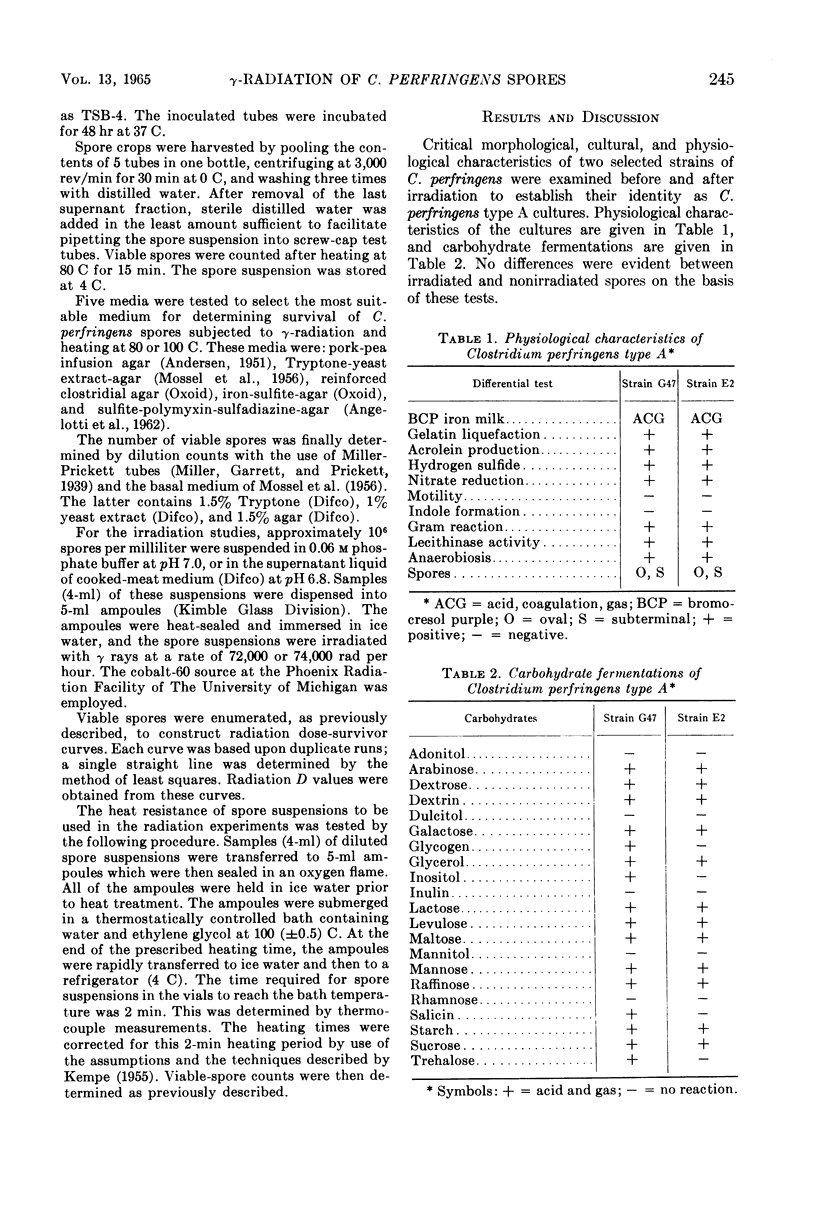Abstract
The radiation resistance of the spores of a classical strain and of an atypical, heat-resistant strain of Clostridium perfringens was determined. Spores were produced in Ellner's and in a Trypticase broth medium. Approximately 106 viable spores per milliliter were suspended in 0.06 m phosphate buffer and irradiated with γ rays from cobalt-60; the survivors were counted in Tryptone-yeast extract-agar by the Prickett-tube technique. Radiation D values for spores of the atypical strain in phosphate buffer and in cooked-meat broth were 0.23 and 0.30 Mrad, respectively, and the D value of the classical strain was 0.25 Mrad in phosphate buffer. Spores of the classical and atypical strains of C. perfringens type A are characterized by differences in heat resistance; yet, all strains tested demonstrated similar radiation resistance. Also, the spores were more resistant to ionizing radiation in cooked-meat broth than in phosphate buffer.
Full text
PDF



Selected References
These references are in PubMed. This may not be the complete list of references from this article.
- ANDERSEN A. A. A rapid plate method of counting spores of Clostridium botulinum. J Bacteriol. 1951 Oct;62(4):425–432. doi: 10.1128/jb.62.4.425-432.1951. [DOI] [PMC free article] [PubMed] [Google Scholar]
- ANGELOTTI R., HALL H. E., FOTER M. J., LEWIS K. H. Quantitation of Clostridium perfringens in foods. Appl Microbiol. 1962 May;10:193–199. doi: 10.1128/am.10.3.193-199.1962. [DOI] [PMC free article] [PubMed] [Google Scholar]
- ELLNER P. D. A medium promoting rapid quantitative sporulation in Clostridium perfringens. J Bacteriol. 1956 Apr;71(4):495–496. doi: 10.1128/jb.71.4.495-496.1956. [DOI] [PMC free article] [PubMed] [Google Scholar]
- HALL H. E., ANGELOTTI R., LEWIS K. H., FOTER M. J. CHARACTERISTICS OF CLOSTRIDIUM PERFRINGENS STRAINS ASSOCIATED WITH FOOD AND FOOD-BORNE DISEASE. J Bacteriol. 1963 May;85:1094–1103. doi: 10.1128/jb.85.5.1094-1103.1963. [DOI] [PMC free article] [PubMed] [Google Scholar]
- HOBBS B. C., SMITH M. E., OAKLEY C. L., WARRACK G. H., CRUICKSHANK J. C. Clostridium welchii food poisoning. J Hyg (Lond) 1953 Mar;51(1):75–101. doi: 10.1017/s0022172400015515. [DOI] [PMC free article] [PubMed] [Google Scholar]
- KEMPE L. L. Combined effects on heat and radiation in food sterilization. Appl Microbiol. 1955 Nov;3(6):346–352. doi: 10.1128/am.3.6.346-352.1955. [DOI] [PMC free article] [PubMed] [Google Scholar]
- McClung L. S. Human Food Poisoning Due to Growth of Clostridium perfringens (C. welchii) in Freshly Cooked Chicken: Preliminary Note. J Bacteriol. 1945 Aug;50(2):229–231. [PMC free article] [PubMed] [Google Scholar]
- WETZLER T. F., MARSHALL J. D., Jr, CARDELLA M. A. Rapid isolation of Clostridiums by selective inhibition of aerobic flora. II. A systematic method as applied to surveys of Clostridiums in Korea. Am J Clin Pathol. 1956 Apr;26(4):345–concl. doi: 10.1093/ajcp/26.4.345. [DOI] [PubMed] [Google Scholar]
- ZEISSLER J., RASSFELD-STERNBERG L. Enteritis necroticans due to Clostridium welchii type F. Br Med J. 1949 Feb 12;1(4597):267–269. doi: 10.1136/bmj.1.4597.267. [DOI] [PMC free article] [PubMed] [Google Scholar]


